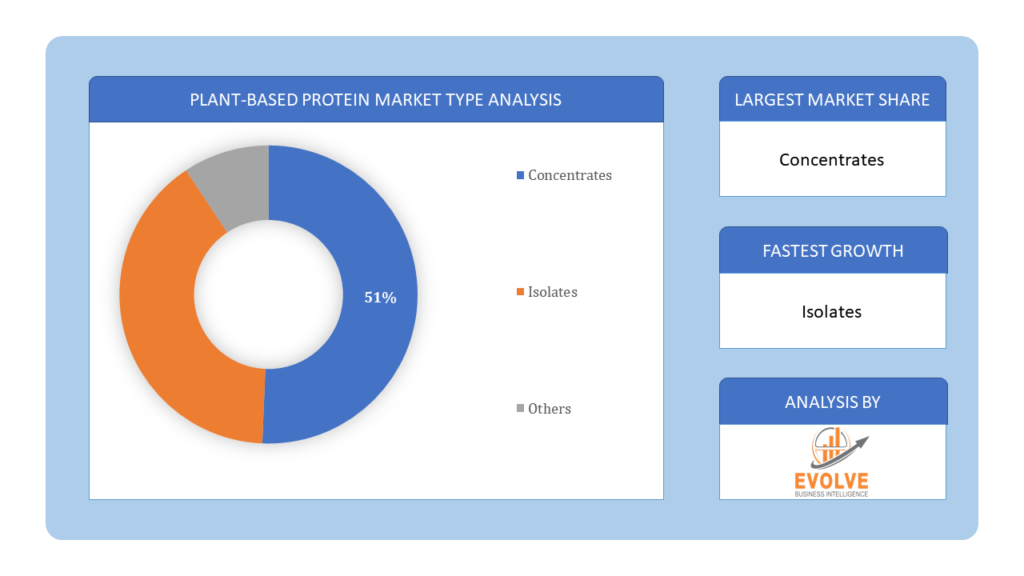Plant-based Protein Market Overview
The Plant-based Protein Market Size is expected to reach USD 35.66 Billion by 2033. The Plant-based Protein Market industry size accounted for USD 24.14 Billion in 2023 and is expected to expand at a compound annual growth rate (CAGR) of 8.74% from 2023 to 2033. The plant-based protein market is the market for products that derive their protein content from plants. This includes a wide range of products, such as tofu, tempeh, lentils, beans, nuts, seeds, and grains. The plant-based protein market is growing rapidly, driven by a Increasing consumer interest in health and wellness and Growing awareness of the environmental impact of animal agriculture
The plant-based protein market is a rapidly growing market with a bright future. As consumers become more aware of the benefits of plant-based protein, the demand for these products is expected to continue to rise. Increasing investment in plant-based protein research and development of new and innovative plant-based protein products
Global Plant-based Protein Market Synopsis
The COVID-19 pandemic has significantly impacted the Plant-based Protein Market. The pandemic has heightened consumer awareness about health and immunity, driving demand for healthier food options, including plant-based proteins. People are more conscious of their diet and its impact on overall health. With lockdowns and restrictions on dining out, more people turned to home cooking. This led to increased experimentation with plant-based recipes and products, boosting sales of plant-based protein ingredients and packaged foods. Plant-based protein producers experienced fewer disruptions compared to the meat industry, which faced significant challenges due to COVID-19 outbreaks in processing plants. This resilience in supply chains contributed to the growth of the plant-based protein market. The shift towards online shopping during the pandemic benefited plant-based protein brands that leveraged e-commerce platforms to reach consumers directly. Many companies saw increased online sales and broadened their customer base.
Plant-based Protein Market Dynamics
The major factors that have impacted the growth of Plant-based Protein Market are as follows:
Drivers:
Ø Health and Wellness Trends
Consumers are becoming more health-conscious, seeking foods that offer nutritional benefits and support overall well-being. Plant-based proteins are often perceived as healthier alternatives to animal proteins due to their lower saturated fat and cholesterol content. There is a growing interest in plant-based diets such as vegetarianism, veganism, and flexitarianism, which emphasize the consumption of plant-derived foods for their health benefits. Younger generations are more open to trying new and alternative food products. They are also more likely to adopt plant-based diets due to their environmental and ethical considerations. The availability of plant-based protein products in mainstream grocery stores, restaurants, and fast-food chains makes it convenient for consumers to access and try these products.
Restraint:
- Perception of Price and Accessibility
Plant-based protein products are often more expensive than their animal-based counterparts due to the costs associated with sourcing raw materials, production processes, and smaller economies of scale. This price difference can be a barrier for cost-conscious consumers. plant-based protein products may not be as widely available, especially in rural or less developed areas. This limits consumer access and adoption. Some consumers may have concerns about the nutritional completeness of plant-based proteins, particularly regarding essential amino acids, vitamins, and minerals that are readily available in animal-based proteins.
Opportunity:
⮚ Technological Advancements
Continued advancements in food technology can improve the taste, texture, and nutritional profile of plant-based proteins, making them more appealing to consumers. Techniques like fermentation, extrusion, and the use of novel ingredients can enhance product quality. Leveraging biotechnology to develop new sources of plant-based proteins, such as algae, fungi, and cultured plant cells, can create unique products that address specific consumer needs. Emphasizing sustainable sourcing practices, such as using non-GMO ingredients and reducing environmental impact, can attract environmentally conscious consumers. Providing transparency about ingredient sourcing, production processes, and environmental impact can build trust and loyalty among consumers who prioritize ethical consumption.
Plant-based Protein Market Segment Overview
By Type
 Based on Type, the market is segmented based on Concentrates, Isolates and Others. The isolate segment holds the largest share of plant-based protein market. Their functional properties that include high concentration of proteins and easily digestible nature boost the market growth. Isolates are produced through various extraction and purification methods designed to separate protein from other components of the plant material, such as carbohydrates, fats, fiber, and minerals.
Based on Type, the market is segmented based on Concentrates, Isolates and Others. The isolate segment holds the largest share of plant-based protein market. Their functional properties that include high concentration of proteins and easily digestible nature boost the market growth. Isolates are produced through various extraction and purification methods designed to separate protein from other components of the plant material, such as carbohydrates, fats, fiber, and minerals.
By Livestock
Based on Livestock, the market segment has been divided into the Pets, Swine, Ruminants and Others. Swine diets traditionally rely on protein sources derived from animal products such as soybean meal and fishmeal. However, there is growing interest in incorporating plant-based protein ingredients to reduce reliance on animal-derived feed ingredients.
By Source
Based on Source, the market segment has been divided into the Soy, Wheat, Pea and Others. Soy is the most dominating segment in plant-based protein market. Soy are highly rich in protein, fiber and are beneficial to digestive health. Soybean meal is a primary protein source in swine diets, providing essential amino acids and nutrients required for growth and production. It is rich in essential amino acids, particularly lysine, methionine, and threonine, which are crucial for animal growth, reproduction, and overall health.
Global Plant-based Protein Market Regional Analysis
Based on region, the global Plant-based Protein Market has been divided into North America, Europe, Asia-Pacific, the Middle East & Africa, and Latin America. North America is projected to dominate the use of the Plant-based Protein Market followed by the Asia-Pacific and Europe regions.
Plant-based Protein North America Market
North America holds a dominant position in the Plant-based Protein Market. North America is one of the largest markets for plant-based proteins, with the United States and Canada leading the way. The region is home to several prominent plant-based protein companies, including Beyond Meat, Impossible Foods, and Oatly. High health awareness, environmental concerns, and a strong vegan and vegetarian culture drive demand. There is a significant market for meat substitutes, dairy alternatives, and protein powders. Wide availability of plant-based products in major retailers, supermarkets, and foodservice establishments.
Plant-based Protein Asia-Pacific Market
The Asia-Pacific region has indeed emerged as the fastest-growing market for the Plant-based Protein Market industry. China, Japan, India, and Australia are leading markets in the Asia-Pacific region. The market is expanding rapidly due to increasing urbanization, disposable incomes, and health awareness. Traditional plant-based diets in countries like India and Japan support market growth. Rising health concerns and the influence of Western dietary habits contribute to increasing demand. Growth of local brands alongside the entry of international companies. Companies like Nestlé and Impossible Foods are expanding their presence in the region.
Competitive Landscape
The global Plant-based Protein Market is highly competitive, with numerous players offering a wide range of software solutions. The competitive landscape is characterized by the presence of established companies, as well as emerging startups and niche players. To increase their market position and attract a wide consumer base, the businesses are employing various strategies, such as product launches, and strategic alliances.
Prominent Players:
- DuPont
- Kerry Group
- Ingredion
- Emsland Group
- AGRANA
- Avebe
- Kroner
- Batory Foods
- AGT Foods
- Aminola
Key Development
In July 2021, Israel-based ChickP Ltd. Declared that its protein isolates can work as 1:1 plant-based substitutes for egg yolk in mayonnaise and salad dressings.
In February 2022, ADM, a global supplier of nutrition that powers many of the world’s top health and wellness and food & beverages brands, released its alternative protein outlook.
Scope of the Report
Global Plant-based Protein Market, by Type
- Concentrates
- Isolates
- Others
Global Plant-based Protein Market, by Livestock
- Pets
- Swine
- Ruminants
- Others
Global Plant-based Protein Market, by Source
- Soy
- Wheat
- Pea
- Others
Global Plant-based Protein Market, by Region
- North America
- US
- Canada
- Mexico
- Europe
- UK
- Germany
- France
- Italy
- Spain
- Benelux
- Nordic
- Rest of Europe
- Asia Pacific
- China
- Japan
- South Korea
- Indonesia
- Austalia
- Malaysia
- India
- Rest of Asia Pacific
- South America
- Brazil
- Argentina
- Rest of South America
- Middle East & Africa
- Saudi Arabia
- UAE
- Egypt
- South Africa
- Rest of Middle East & Africa
| Parameters | Indicators |
|---|---|
| Market Size | 2033: $35.66 Billion |
| CAGR | 8.74% CAGR (2023-2033) |
| Base year | 2022 |
| Forecast Period | 2023-2033 |
| Historical Data | 2021 |
| Report Coverage | Revenue Forecast, Competitive Landscape, Growth Factors, and Trends |
| Key Segmentations | Type, Livestock, Source |
| Geographies Covered | North America, Europe, Asia-Pacific, Latin America, Middle East, Africa |
| Key Vendors | DuPont, Kerry Group, Ingredion, Emsland Group, AGRANA, Avebe, Kroner, Batory Foods, AGT Foods and Aminola. |
| Key Market Opportunities | • Technological Advancements • Sustainable Sourcing |
| Key Market Drivers | • Health and Wellness Trends • Changing Consumer Preferences |
REPORT CONTENT BRIEF:
- High-level analysis of the current and future Plant-based Protein Market trends and opportunities
- Detailed analysis of current market drivers, restraining factors, and opportunities in the future
- Plant-based Protein Market historical market size for the year 2021, and forecast from 2023 to 2033
- Plant-based Protein Market share analysis at each product level
- Competitor analysis with detailed insight into its product segment, Government & Defense strength, and strategies adopted.
- Identifies key strategies adopted including product launches and developments, mergers and acquisitions, joint ventures, collaborations, and partnerships as well as funding taken and investment done, among others.
- To identify and understand the various factors involved in the global Plant-based Protein Market affected by the pandemic
- To provide a detailed insight into the major companies operating in the market. The profiling will include the Government & Defense health of the company’s past 2-3 years with segmental and regional revenue breakup, product offering, recent developments, SWOT analysis, and key strategies.








